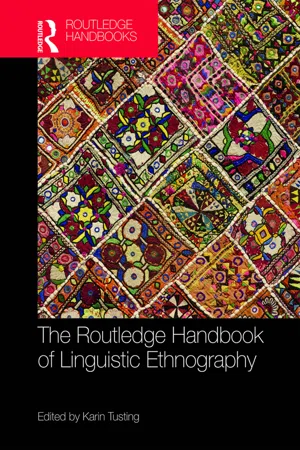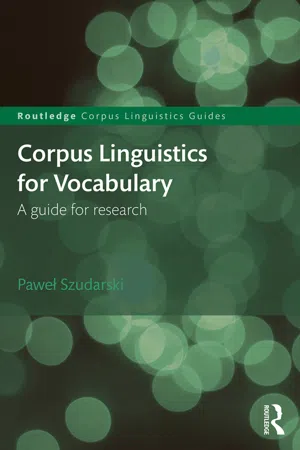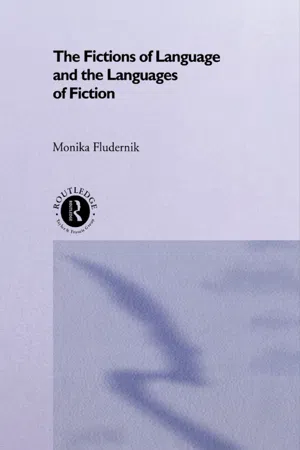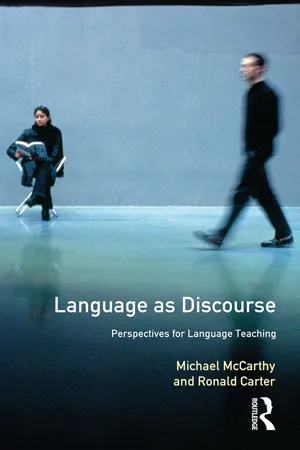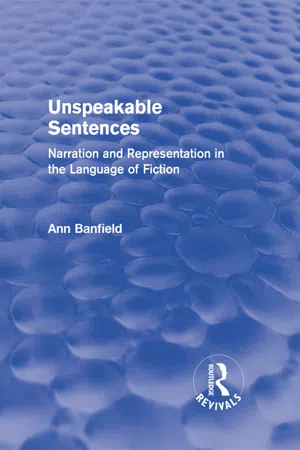Direct Discourse
Direct discourse refers to the exact words spoken by a person, often presented within quotation marks. It is a way of directly quoting someone's speech or thoughts. In linguistics, direct discourse is used to analyze the structure and syntax of spoken language, as well as to convey the precise words and expressions used by a speaker.
8 Key excerpts on "Direct Discourse"
- eBook - ePub
- Karin Tusting, Karin Tusting(Authors)
- 2019(Publication Date)
- Routledge(Publisher)
...Three defining, interrelated areas can broadly be identified in this regard. 1 English translation: “Spoken public oratory which develops a particular topic.” 2 English translation: “A spoken or written concrete actualisation of the abstract system of language.” Viewed from within a linguistic project, ‘discourse’ emerged in the 1960s and 1970s to refer to specific language phenomena which are characteristic of running text and ongoing interaction, in short, with a stress on authentic language data and on pushing formal and functional enquiry both beyond the bounds of the isolated grammatical sentence and the self-constructed language datum. From within a sociolinguistic and anthropological project, ‘discourse’ has been instrumental in developing a qualitative research agenda on the role of language use in social life. In the background is an interactional and a performative view on language use in its complex manifestations. Language use is viewed as social action, and studying this is key to an understanding of its role in a larger project of understanding societies and cultures. Finally, as the term ‘discourse’ also surfaced in social theoretical work, it has become a metaphor for capturing processes and practices of socio-cultural representation. In this view, representations are seen as imbued by world view, permeated by ideology, central to the construction of identities, and they often count as rationalisations of power relationships. This tradition descends from post-structuralist thought and deconstructivist traditions in critical enquiry. Attending to the first area of definition, the development of a scientific object referred to as ‘discourse’ resulted in a major breakthrough in linguistics’ efforts to unravel the nature of naturally occurring language use and to do so with specific reference to formal-functional properties characteristic of running text and ongoing interaction, as well as locating areas of meaning relative to situation, purpose and user...
- eBook - ePub
Corpus Linguistics for Vocabulary
A Guide for Research
- Paweł Szudarski(Author)
- 2017(Publication Date)
- Routledge(Publisher)
...p.160 Chapter 9 Discourse, pragmatics and vocabulary 9.1 What is discourse and discourse analysis? Discourse is a notoriously difficult term to define but in general “it refers to units of language above the level of the sentence” (McEnery and Hardie 2012: 132). In a detailed definition, Thornbury (2010) enumerates three main senses of the term: discourse as connected text, discourse as language in use and discourse as social practices. Similarly, Gee (1999) distinguishes between discourse (with a little d) and Discourse (with a capital D). While the former is concerned with language in use in specific contexts, the latter involves not only linguistic practices but also systems of knowledge, beliefs and other elements of social life. This distinction is also reflected in Groom, Charles and John’s (2015) discussion of discourse-oriented approaches. The authors posit that there are two basic types of discourse analysis: the first one concentrates on the structure of different kinds of interactions and the other is the study of conventionalized meanings, values and ideologies held by specific social groups. What transpires from the above definitions is that discourse analysis is an umbrella term and it encompasses a set of mainly qualitative methods and practices aimed at exploring specific examples of language in use and studying how meaning emerges in the process of interaction (Biber, Connor and Upton 2007). Corpus linguistics, in turn, tends to be perceived as a quantitative methodology, which relies on frequency data and statistical procedures and seeks to reveal typical patterns of natural language use. It becomes evident then that there are inherent differences between these two approaches to the study of language...
- eBook - ePub
Narrative
A Critical Linguistic Introduction
- Michael Toolan(Author)
- 2012(Publication Date)
- Routledge(Publisher)
...Both hard news and human interest stories in newspapers, for example, are heavily dependent on direct and indirect speech reporting of the actual words of those involved. Direct speech pretends to be a faithful verbatim report of a person’s actual words (although we accept, in literature and in non-literary contexts, that all sorts of likely pauses, reformulations, repairs, and dialectal features are partially if not completely removed). If direct speech reporting of, e.g., a sports celebrity in a newspaper story purports or pretends to be a faithful record of the actual words spoken, then direct speech in fiction is a simulation of a pretence; and sometimes the author may choose not to pretend or simulate very hard – just as Shaw or Beckett did not feel bound in their plays to give their characters dialogue that sounded undetectably similar to everyday natural conversation. In indirect speech, the narrator or reporter purports to provide an accurate version of what the speaker said, but not by simply reproducing that speaker’s own words: instead, the narrator’s words and deictic orientation are retained. Accordingly, indirect speech versions can be fairly remote from their hypothesized direct speech source. Thus Leech and Short (1981: 323) note the use of quite summarized and remote versions of indirect speech. And while the privileges of occurrence of all eleven speech and thought presenting modes are notionally equal, the actual use and distribution of the modes may vary in striking ways. Indirect Speech, for example, is extremely sparingly used in the exemplary short stories (‘Eveline’, ‘That Evening Sun’, etc.) of this study. On the other hand it is extensively used in certain kinds of oral narratives and in newspaper stories. 5.3 Differences between Direct and InDirect Discourse We can list some of the formal ways in which InDirect Discourse (IS or IT) normally differs from Direct Discourse (DS or DT)...
- Monika Fludernik(Author)
- 2003(Publication Date)
- Routledge(Publisher)
...A similar conclusion, we may want to add, holds true for the distribution of irony and empathy. Whereas, as Leech/Short correctly note, the rendering of utterances privileges DS (but—one has to add -only in oral discourse and most literary language; in journalism inDirect Discourse and even free inDirect Discourse outweigh Direct Discourse passages), in the representation of consciousness Direct Discourse is the least common technique (except in the interior monologue of the twentieth-century novel), with a traditional preponderance of psycho-narration and, in second place, free inDirect Discourse, which comes close to competing with psycho-narration in late-nineteenth- and early-twentieth-century fiction. 12 Free inDirect Discourse rarely displaces psycho-narration from its quantitatively dominant position, except perhaps in Faulkner’s Go Down, Moses. 13 Although free inDirect Discourse representations of consciousness are either empathetic or ironical (consonant or dissonant, as Cohn 1978 would say), 14 free inDirect Discourse passages representing speech, on the other hand, appear in the ironical or neutral mode— no empathy effect can be discovered. The reason for this imbalance seems to lie in the perceptibility of speech and the imperceptibility of consciousness—empathy with a character’s mind becomes possible only if one gains access to that mind through internal focalization, whereas utterances are generally available story elements. Another scale model has been proposed by Josef Kurz (1970) in the wake of Kaufmann (1976). Kurz distinguishes between Direct Discourse (‘direkte Redewiedergabe’), inDirect Discourse (‘indirekte Redewiedergabe’) and ‘free’ inDirect Discourse (‘freie indirekte Redewiedergabe’, i.e. the German non-subordinated inDirect Discourse in the subjunctive), ‘Redebericht’ (a report of a speech event), ‘nacherlebte Rede’ (i.e. free inDirect Discourse), and ‘abstrahierte (verallgemeinerte) Rede’...
- eBook - ePub
Researching Discourse
A Student Guide
- Christopher Hart, Christopher Hart(Authors)
- 2020(Publication Date)
- Routledge(Publisher)
...More recently, ‘discourse’ has meant: The action or process of communicating thought by means of the spoken word; interchange of words; conversation, talk. Also: the words exchanged by this means; speech. In later use also: the written representation of this; communication in written form. The most current definitions are, in general contexts, (a): The body of statements, analysis, opinions, etc., relating to a particular domain of intellectual or social activity, esp. as characterized by recurring themes, concepts, or values; (also) the set of shared beliefs, values, etc., implied or expressed by this. Frequently with of or modifying word. And in a more specifically linguistic sense, (b): A connected series of utterances by which meaning is communicated, esp. one forming a unit for analysis; spoken or written communication regarded as consisting of such utterances. Since you are reading this book, you are probably already familiar with the concepts summarised by (a) and (b) above, but it is worth pointing out that the broad academic enterprise of discourse analysis may involve placing different degrees of emphasis on the different perspectives suggested by (a) and (b). Notice particularly the coda in (a): ‘Frequently with of or modifying word’. This extra information indicates that ‘discourse’ often occurs in formulations such as these: the discourse of multiculturalism discourses of masculinity the discourse of colonialism political discourse feminist discourse dominant discourse Now, these phrases would seem to relate more readily to definition (a) – i.e. to ‘particular domain[s] of … social activity’ and their ‘shared beliefs [and] values’ – than to definition (b), which is more formal, concerned with ‘series of utterances’ or sentences and the way these are ‘connected’ linguistically. Yet many discourse analysts, including those who have contributed to this book, do research that bridges both senses of the term ‘discourse’...
- eBook - ePub
Language as Discourse
Perspectives for Language Teaching
- Michael Mccarthy, Ronald Carter(Authors)
- 2014(Publication Date)
- Routledge(Publisher)
...Increasingly, literary texts are becoming a subject for discourse analysis; indeed, the term discourse stylistics now refers to the practice of using discourse analysis in the study of literary texts (see Carter and Simpson 1989: 11). Through a contextually oriented approach of this kind much can be revealed: for example, the relationships between characters in novels and plays; the nature of the spoken voice in both prose and poetry; patterns in narrative organization; the differences and similarities between literary and non-literary texts as social discourse in contexts of use. This approach also means that questions concerning the relationship between language and culture cannot be ignored. Such questions naturally lead us to consider the relationship between language, text and ideology. In turn, discourse analysis cannot really avoid the question: what is literature? Such questions also have important implications for the use of literature in the classroom, especially in the context of language teaching. Answers to these questions affect the criteria for the division of the world of discourse which was the subject of Chapter 1, the subsequent selection of texts for the syllabus, the sequence in which they are studied, teaching methodology and the nature of the literature curriculum. 4.1 Conversational analysis: pragmatics and style Two good starting-points for the analysis of literary discourse are fictional and drama dialogue since the functions of such stretches of language normally require explanation by reference to language organization beyond the sentence or the single conversational turn. Quite often, this will involve ‘making sense’ of language which on the surface appears to make no sense at all. Modern dramatists, in particular, draw extensively on such patterns of discourse. For example, the famous ending of Waiting for Godot by Samuel Beckett (1956): VLADIMIR: Well. Shall we go? ESTRAGON: Yes...
- eBook - ePub
Unspeakable Sentences (Routledge Revivals)
Narration and Representation in the Language of Fiction
- Ann Banfield(Author)
- 2014(Publication Date)
- Routledge(Publisher)
...(In its ability to become part of the spoken language, direct speech differs from represented speech and thought, as we shall see.) The discourse parenthetical, by contrast, is an oral form, one which, like the exclamation, makes reference to the speaker. It interests us just in so far as its differences shed light on the narrative parenthetical. It is this latter which concerns us here, because only it is anaphorically related to an E of represented speech and thought. The difference between the two types of parenthetical which is the immediate focus of our attention is an interpretive and not a syntactic one. The discourse parenthetical is ‘speaker oriented,’ in Reinhart’s terminology, while the narrative parenthetical is ‘parenthetical-subject oriented.’ In other words, the narrative parenthetical assigns point of view, not to the E’s speaker, but to the referent of the parenthetical verb’s subject. As a consequence, it appears that the E of represented speech and thought violates 1 E/1 SPEAKER & PRESENT. We will have to determine whether this is the case or not. Before turning to this, I summarize for ease of reference the differences just discussed between narrative and discourse parentheticals. A fuller explanation of these features will be taken up in appropriate sections. Narrative parentheticals Discourse parentheticals (i) parenthetical-subject’s point of view speaker’s point of view (ii) sequence-of-tense agreement independence of tense (iii) backward anaphora no restriction on anaphora (iv) subject-verb inversion allowed subject-verb inversion excluded (v) absolute exclusion of negation syntactic (but not semantic) negation allowed (vi) absolute exclusion of question inversion syntactic (but not semantic) question allowed (vii) wider range of verbs narrow range of verbs The exclusion of negation and of question-inversion in parentheticals (cf...
- eBook - ePub
A Contrastive View of Discourse Markers
Discourse Markers of Saying in English and French
- Laure Lansari(Author)
- 2019(Publication Date)
- Palgrave Macmillan(Publisher)
...In the enunciative tradition, on the other hand, DMs with the verb dire have received a lot of scholarly attention, in relation to the notion of metalinguistic reflexivity. This contrast between the two linguistic traditions is actually meaningful. Epistemologically speaking, it is striking to note that reflexivity has been called upon in pragmatic works only recently and rather marginally (Aijmer 2013 ; Beeching 2017). By contrast, it has always played a crucial role in enunciative theories, not specifically in relation to DMs but more generally in connection to human language communication. In an article devoted to the relationship between language and society, Benveniste (1974) highlighted the uniqueness of human language communication when compared to other semiotic systems: human language communication is the only semiotic system characterised by metalinguistic reflexivity, i.e. the ability to use language to comment on language. Culioli (1967) similarly pointed out that metalinguistic reflexivity is a unique feature of human language. The emphasis laid on this reflexive dimension is linked to the communication model underlying “énonciation”. In this theoretical framework, language communication is not a straightforward process whereby a speaker intentionally conveys a message to the addressee in order to act on them and/or on the world. Language communication is on the contrary seen as a complex, dynamic intersubjective construct where meaning is constantly negotiated between speakers. 13 Instability is thus at the core of communication: speakers choose specific linguistic markers but as discourse unfolds they may comment on, suppress or replace them in order to adjust more adequately to the co-speaker’s expectations and/or to the reality they try to express...
